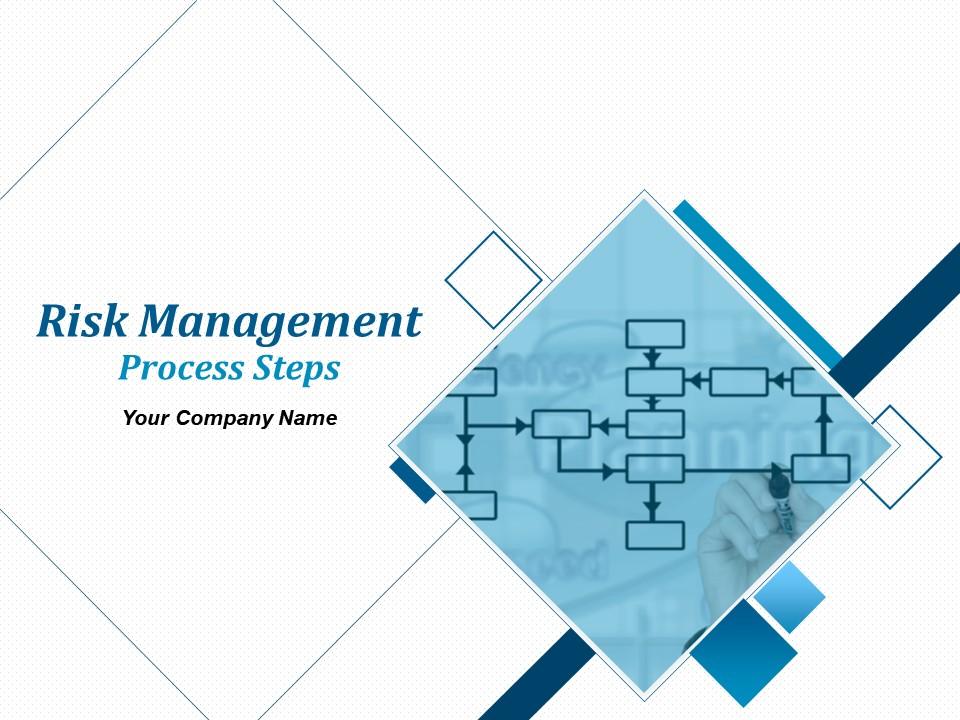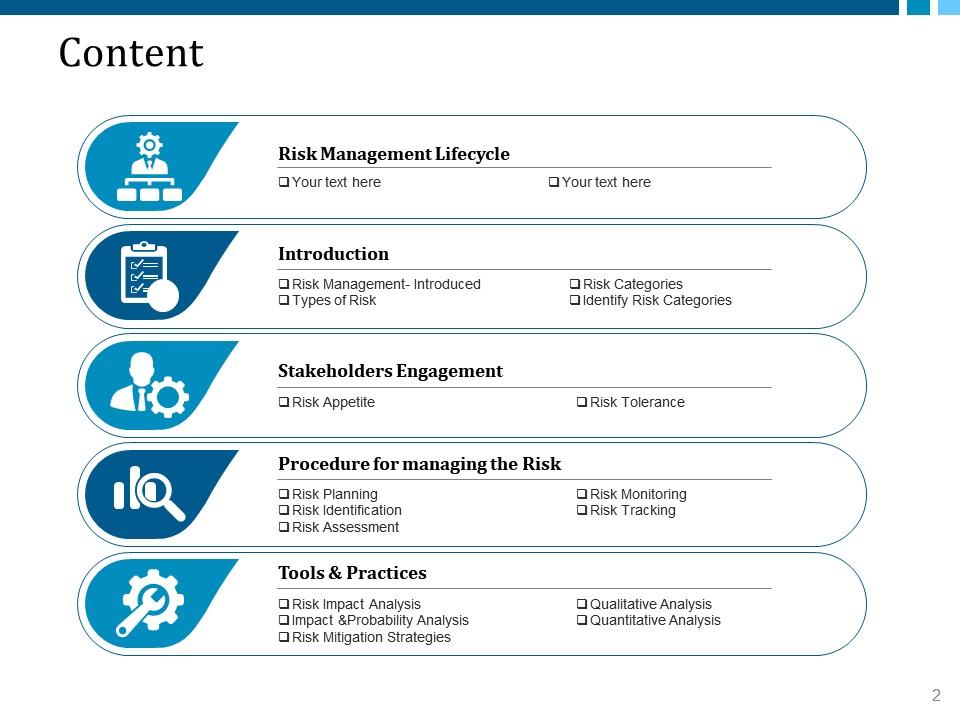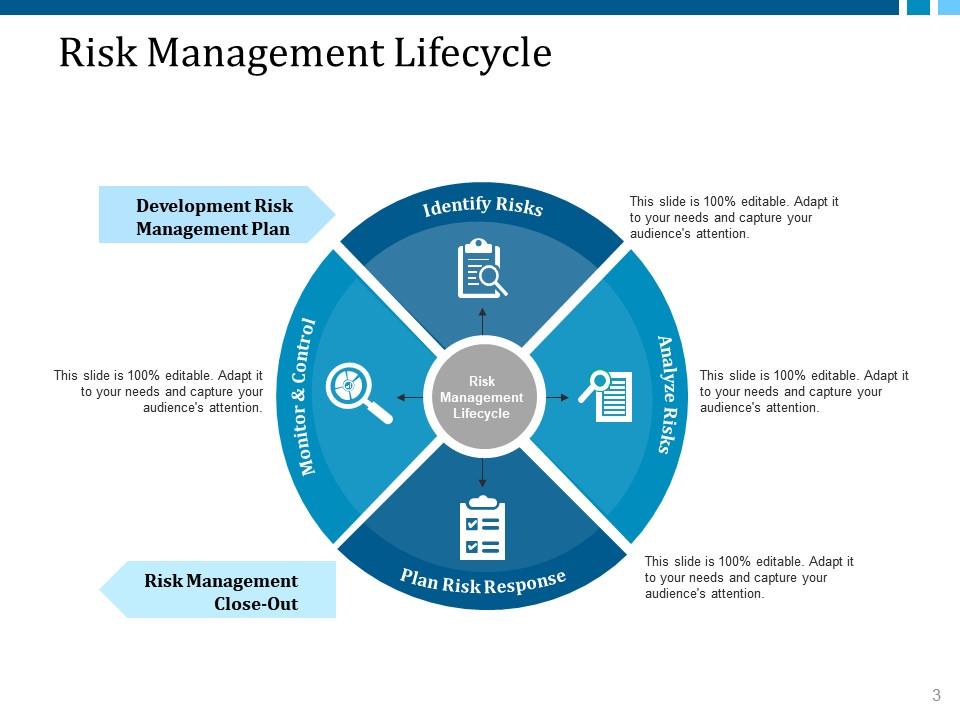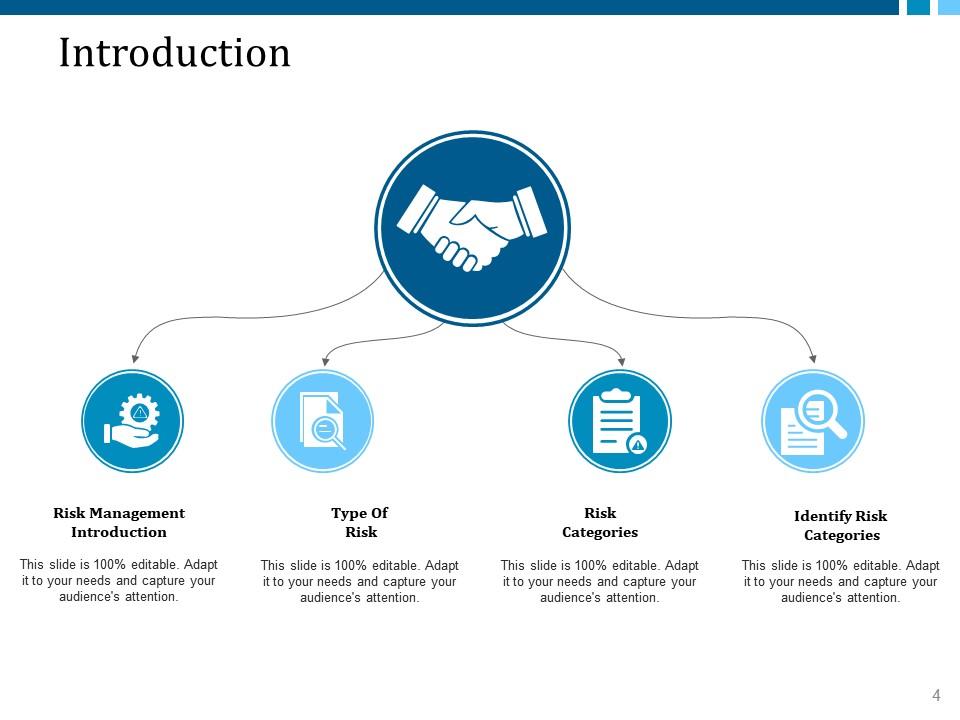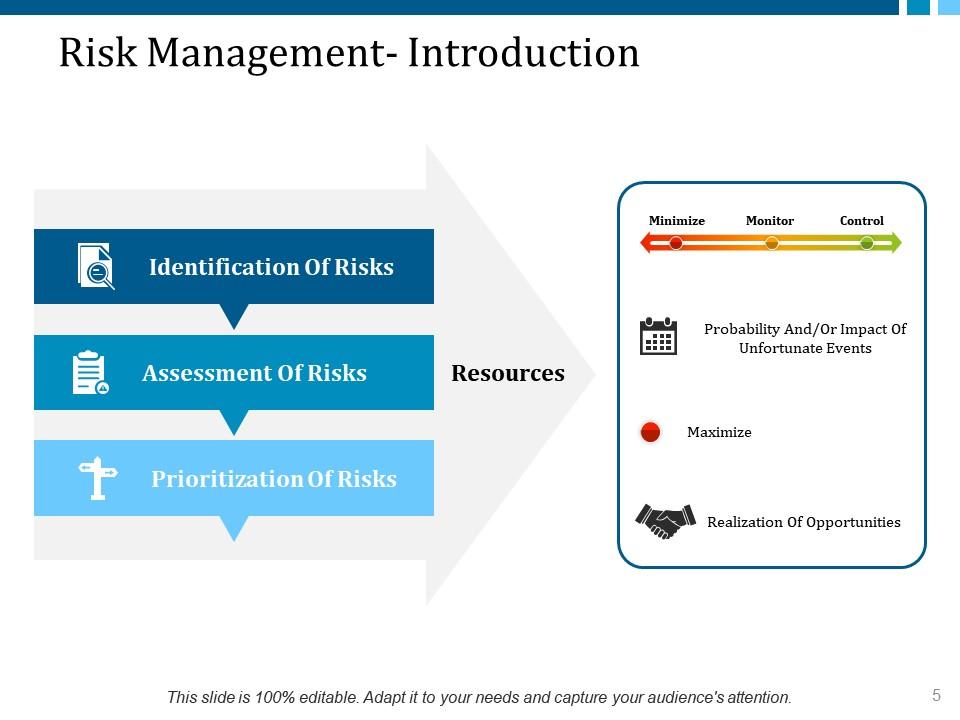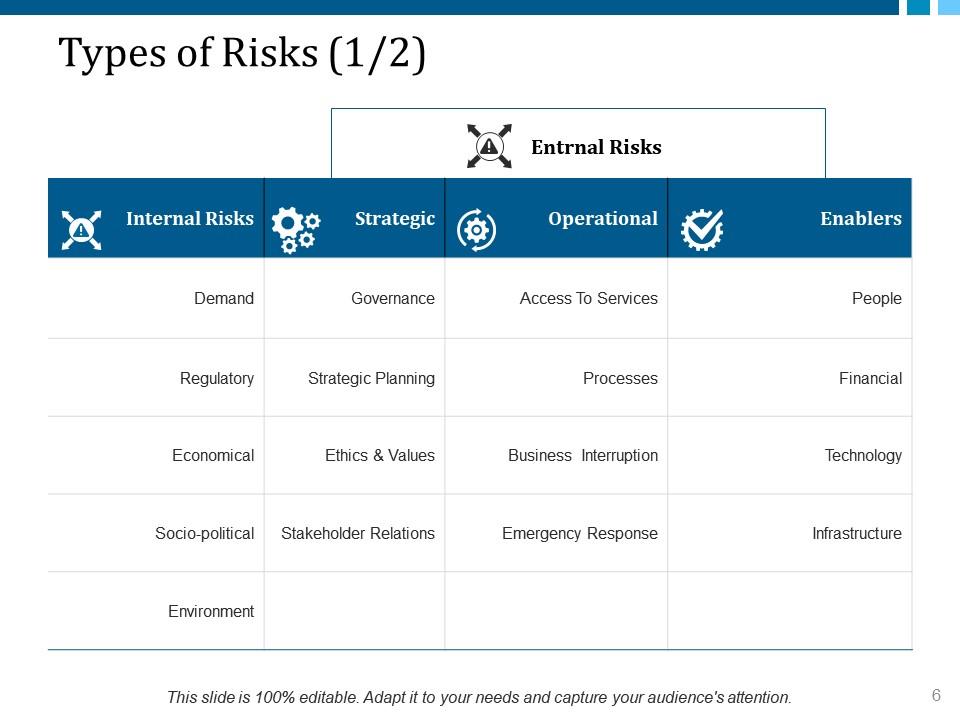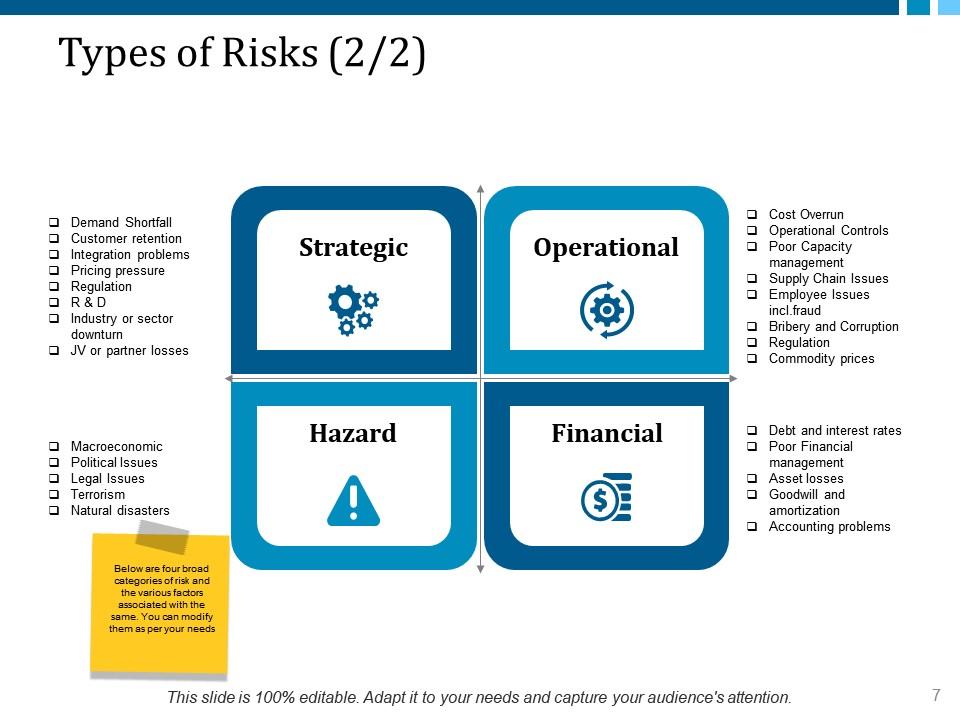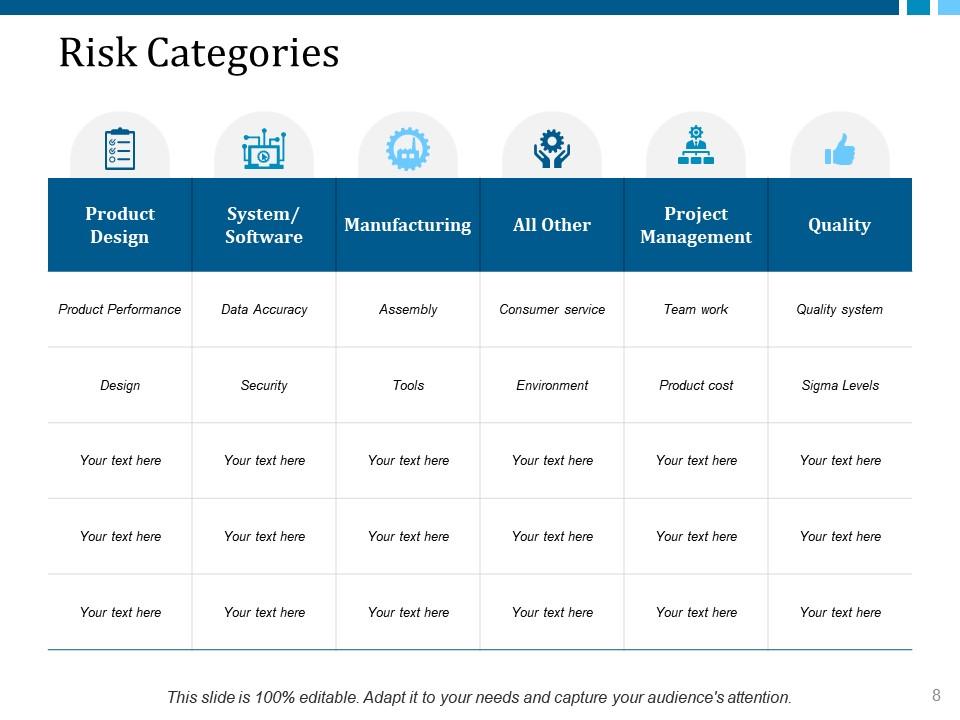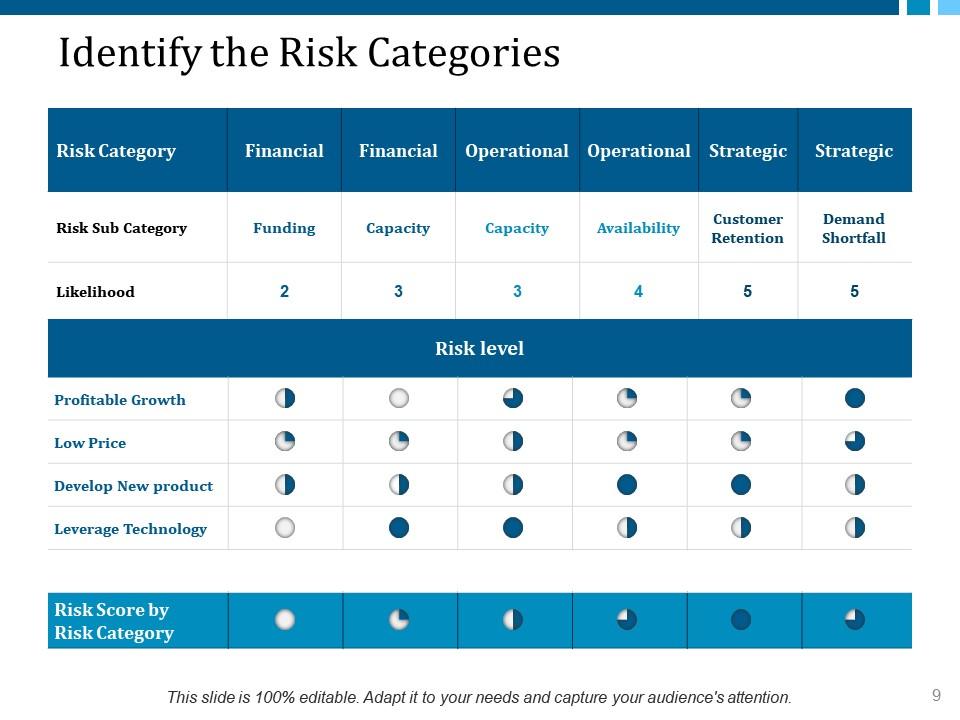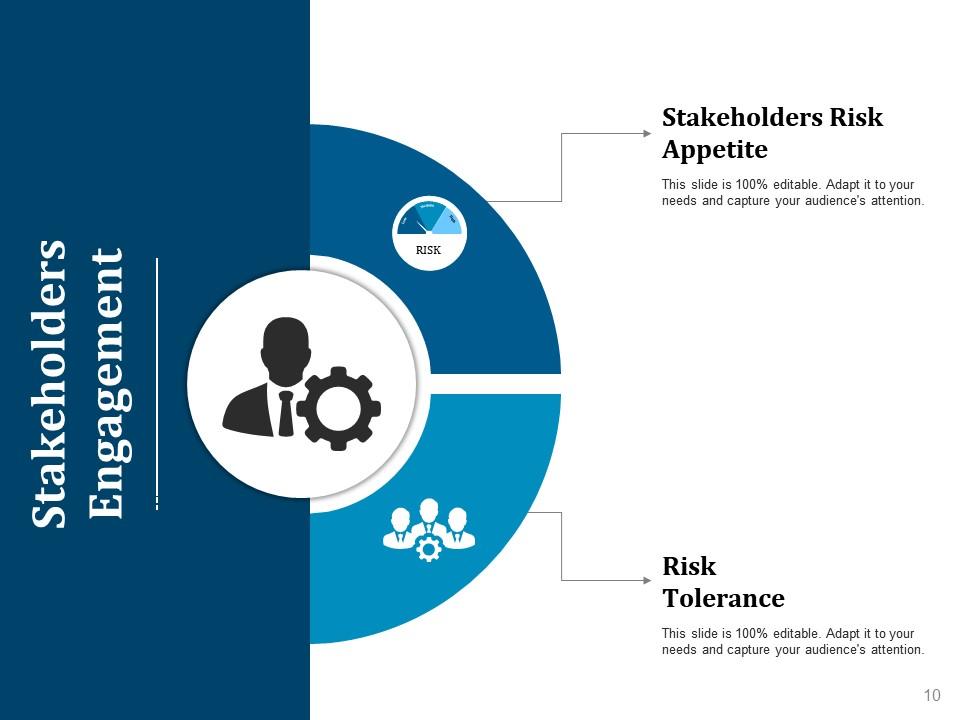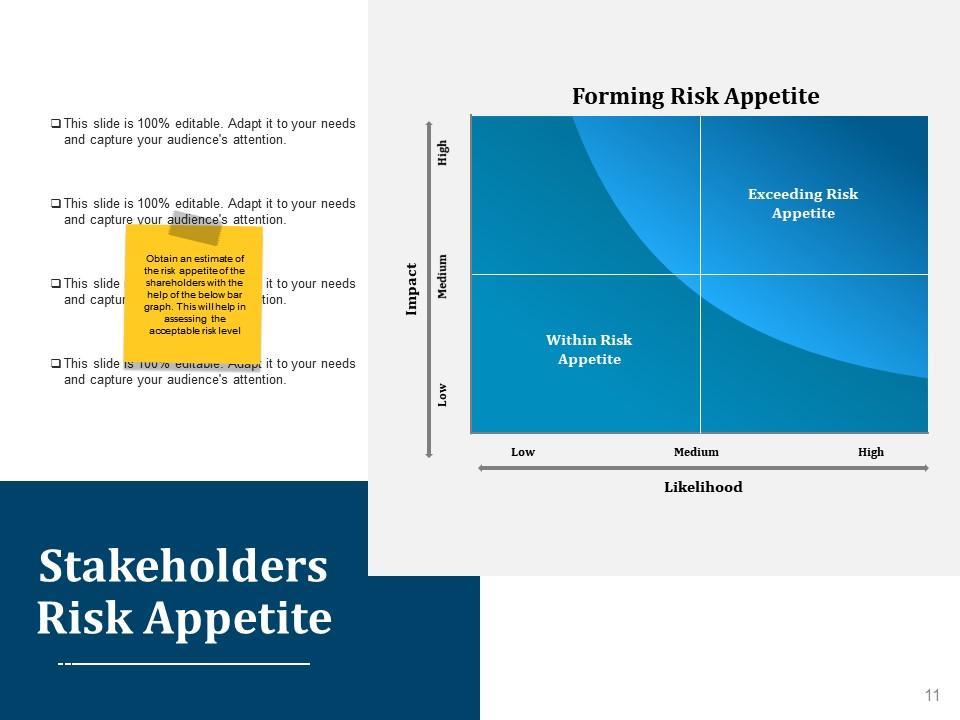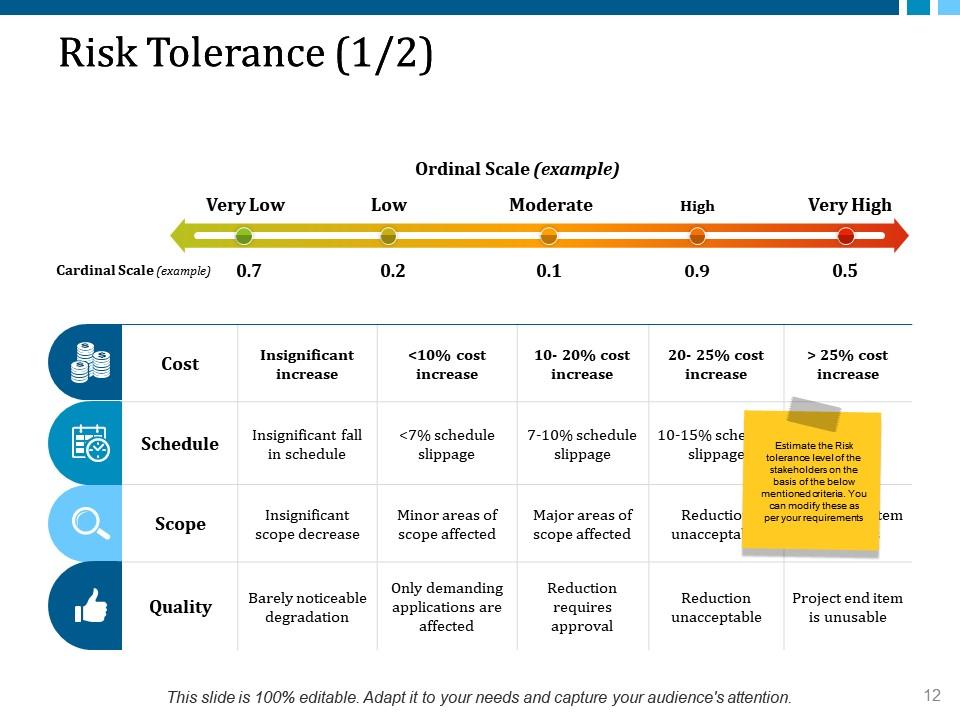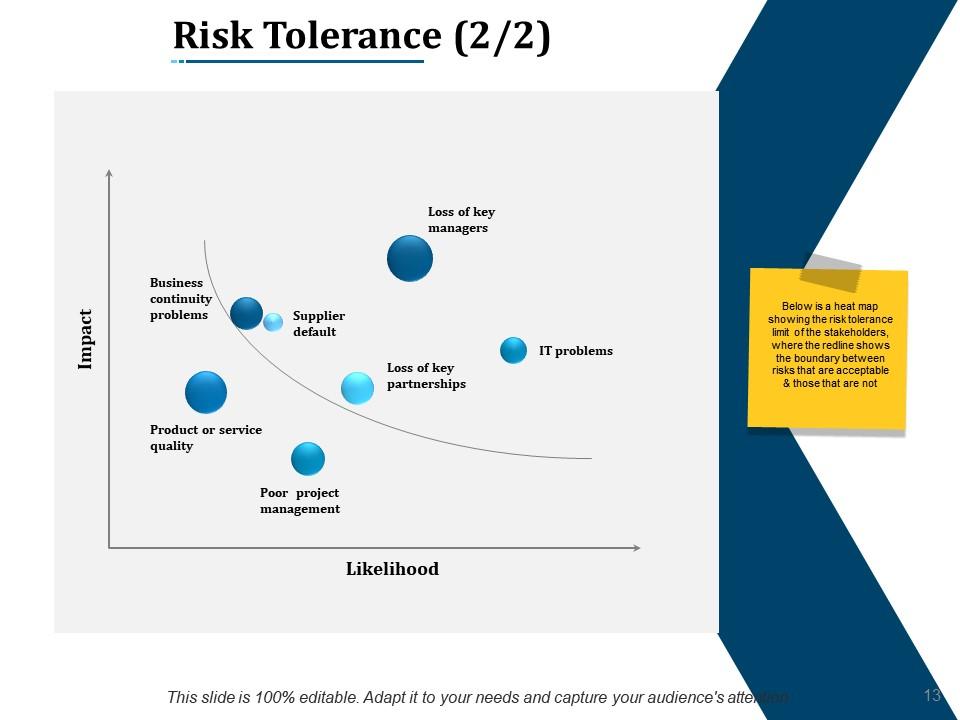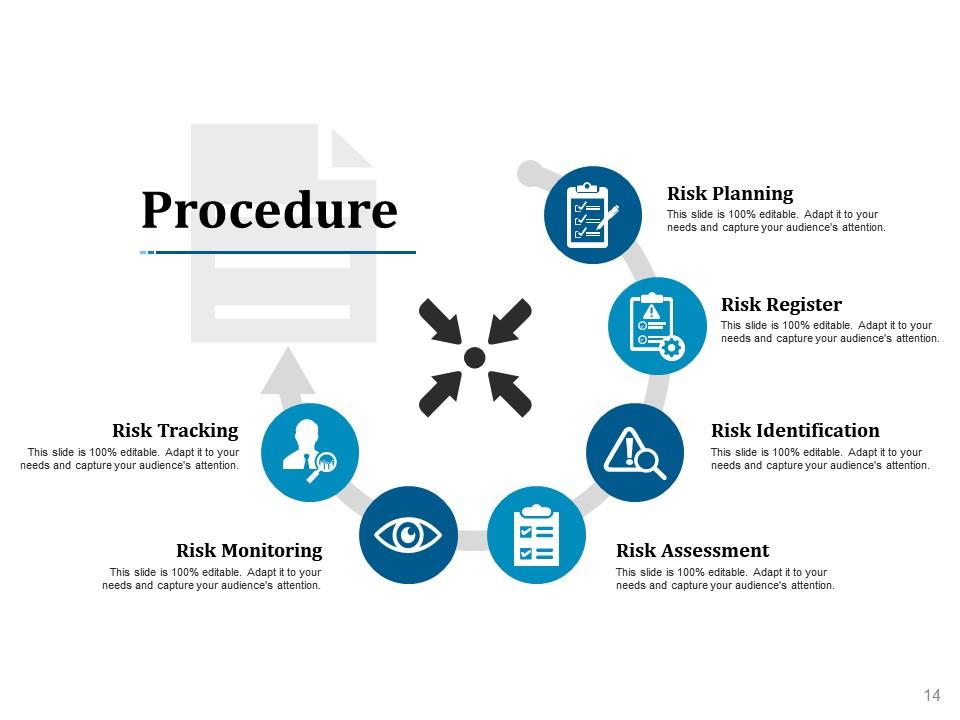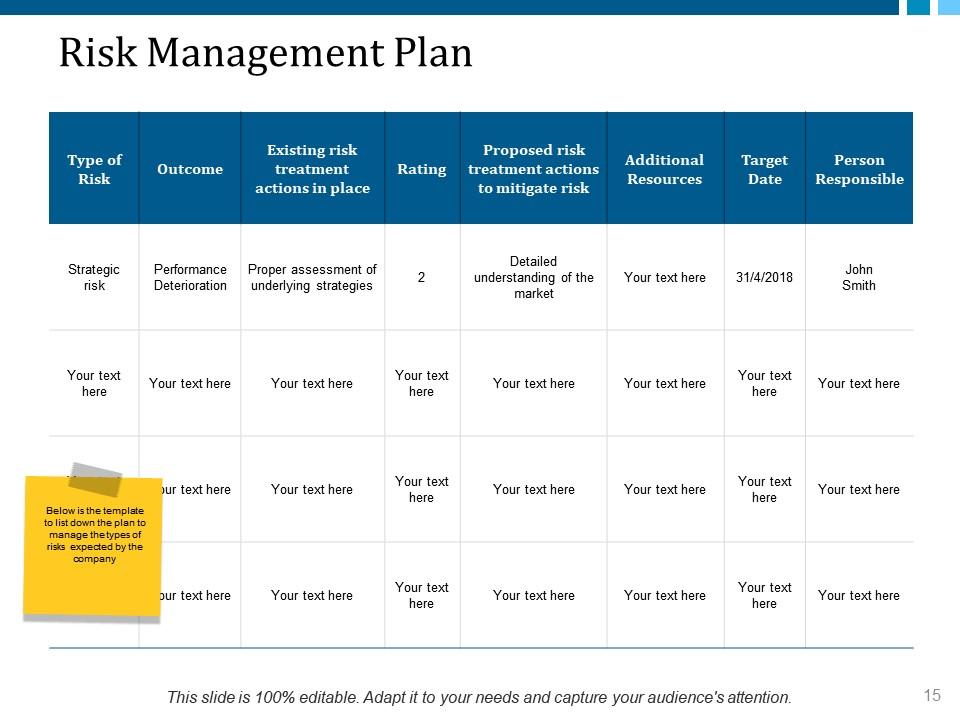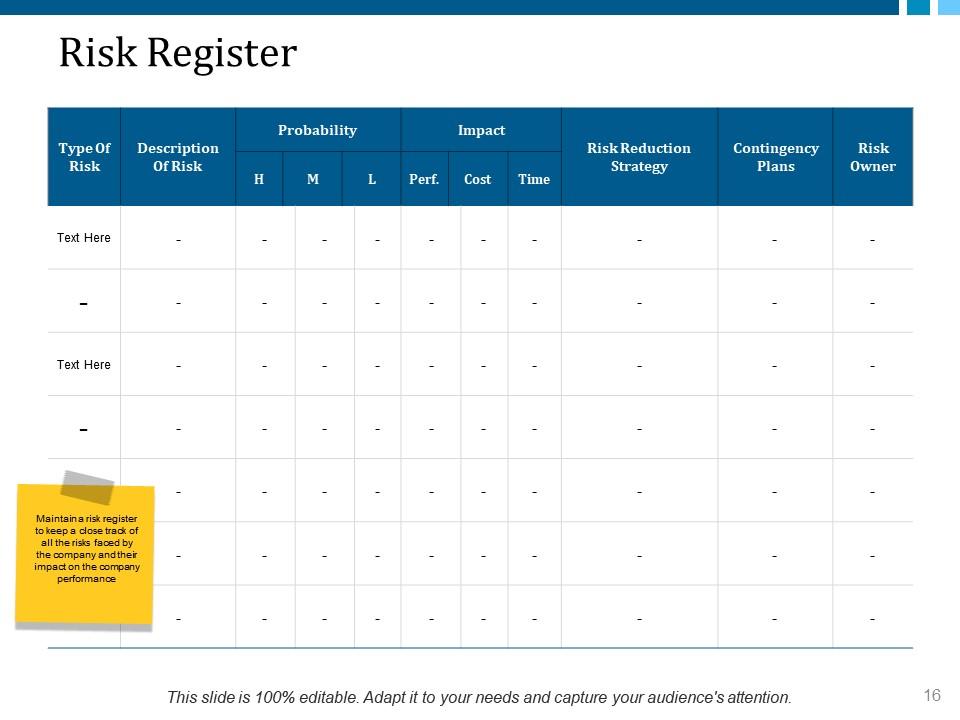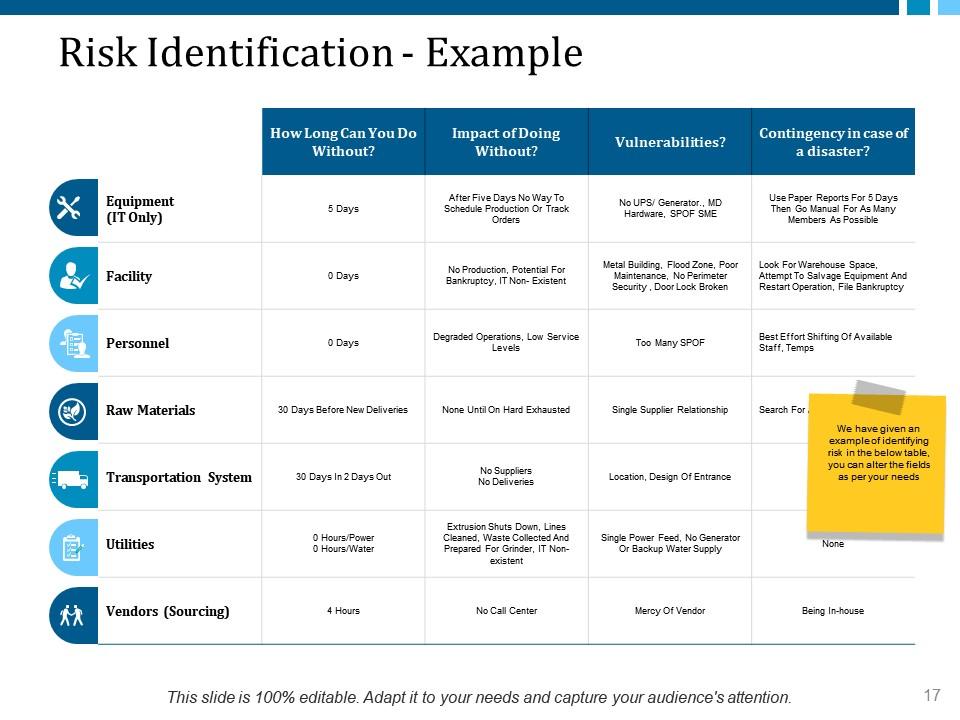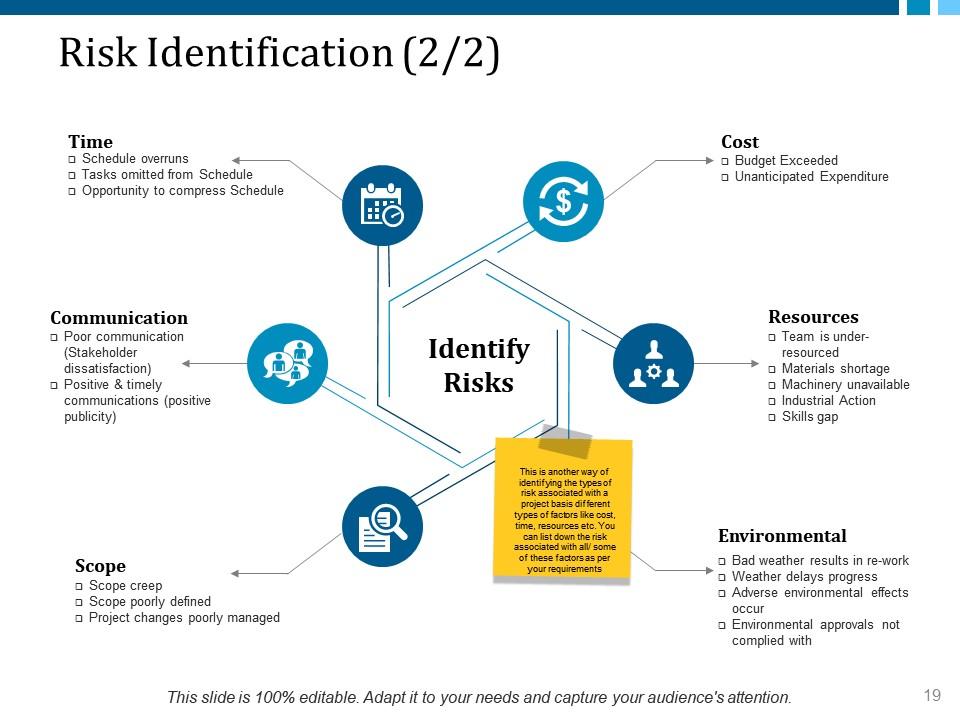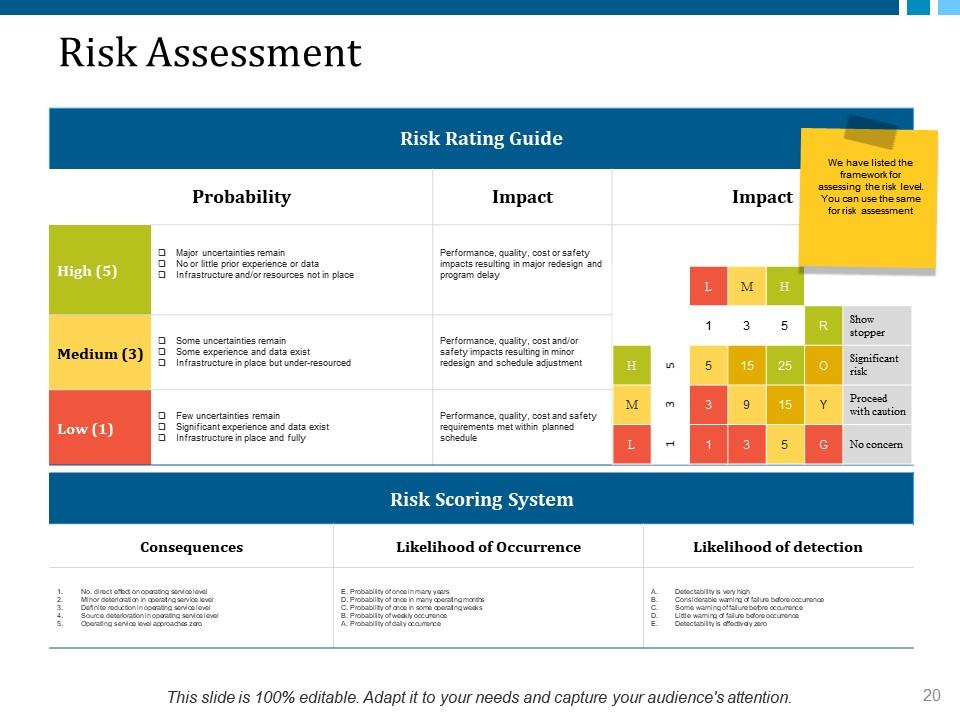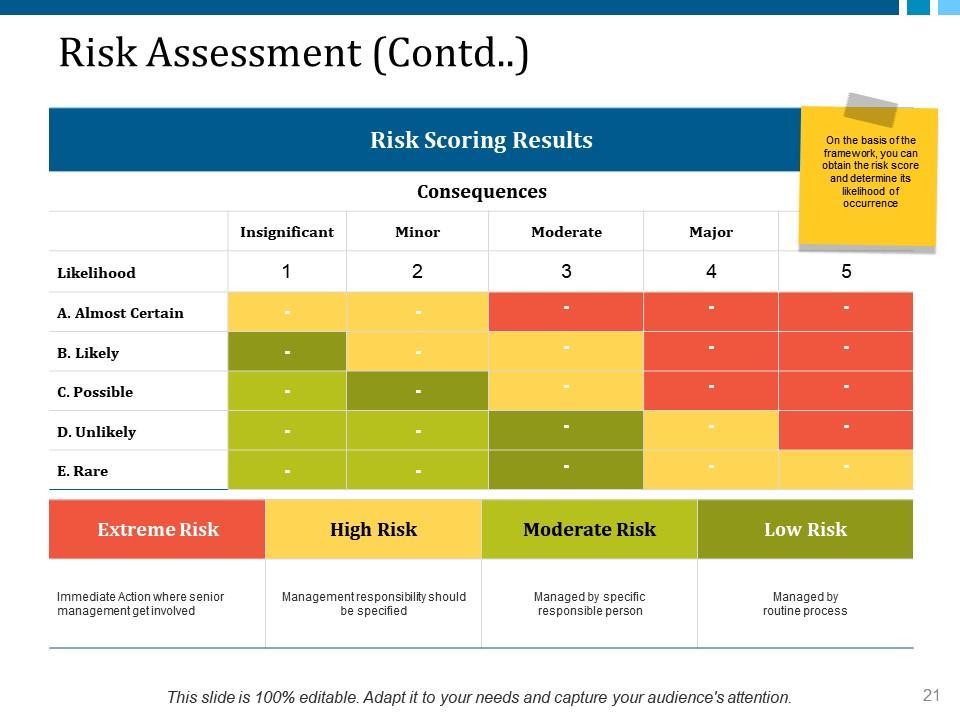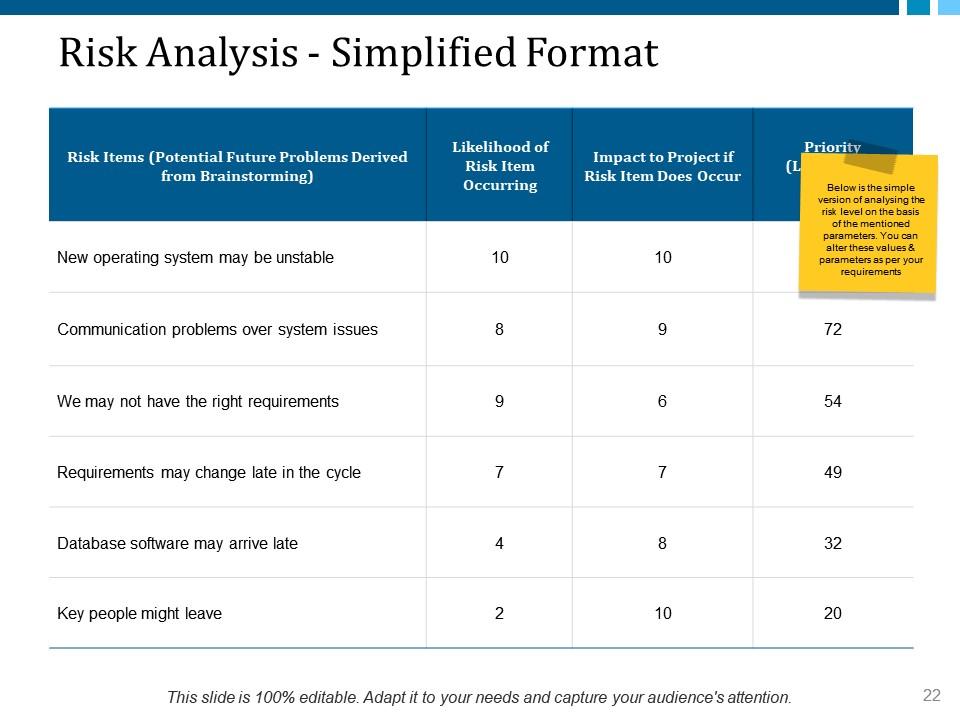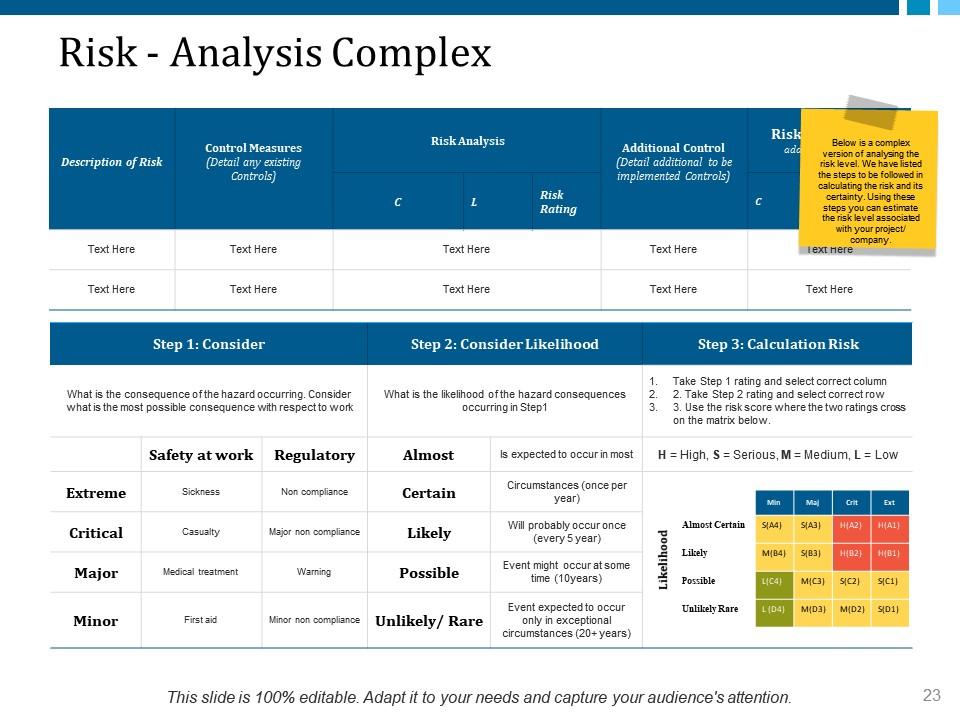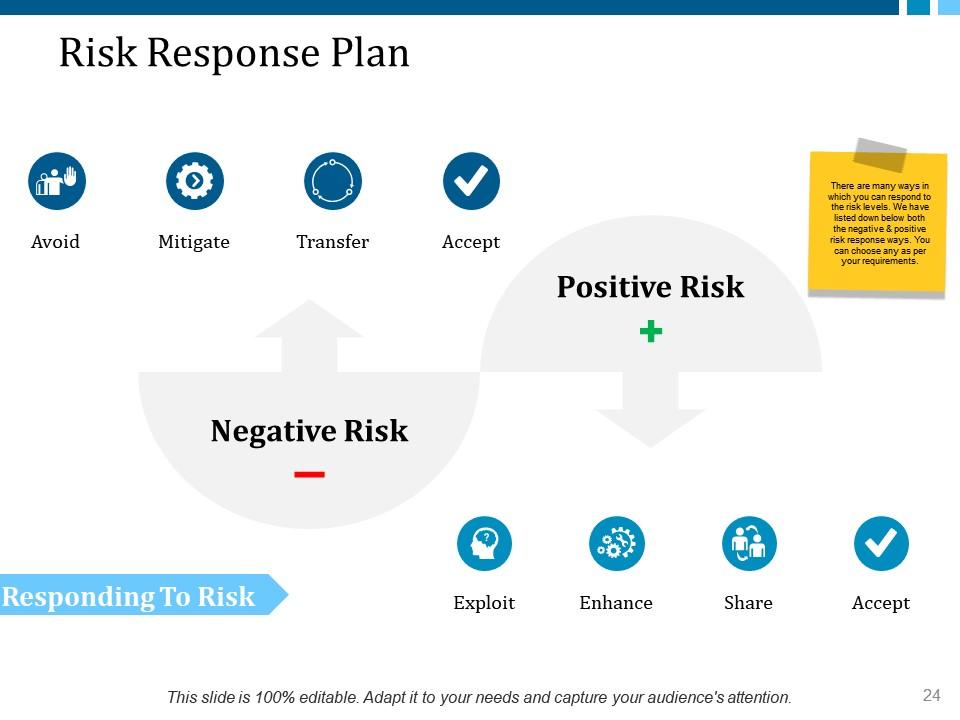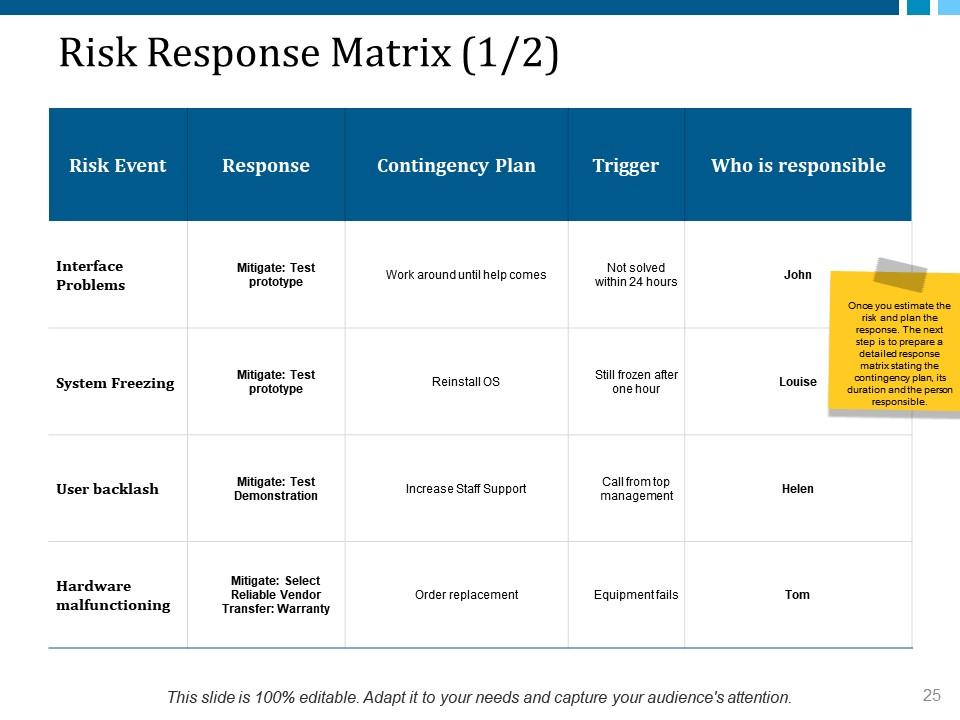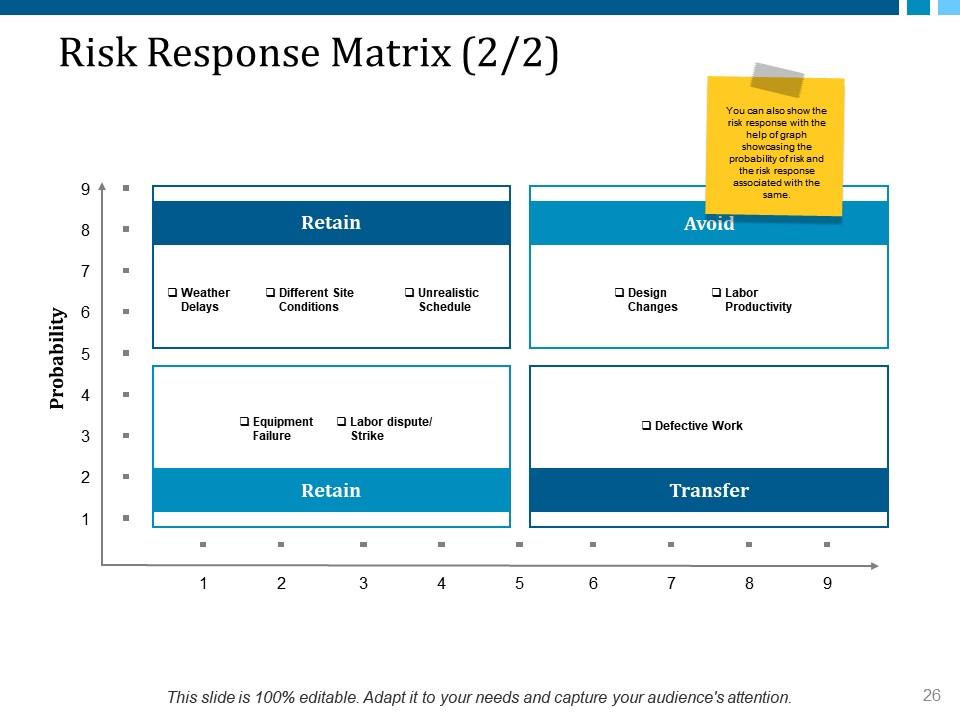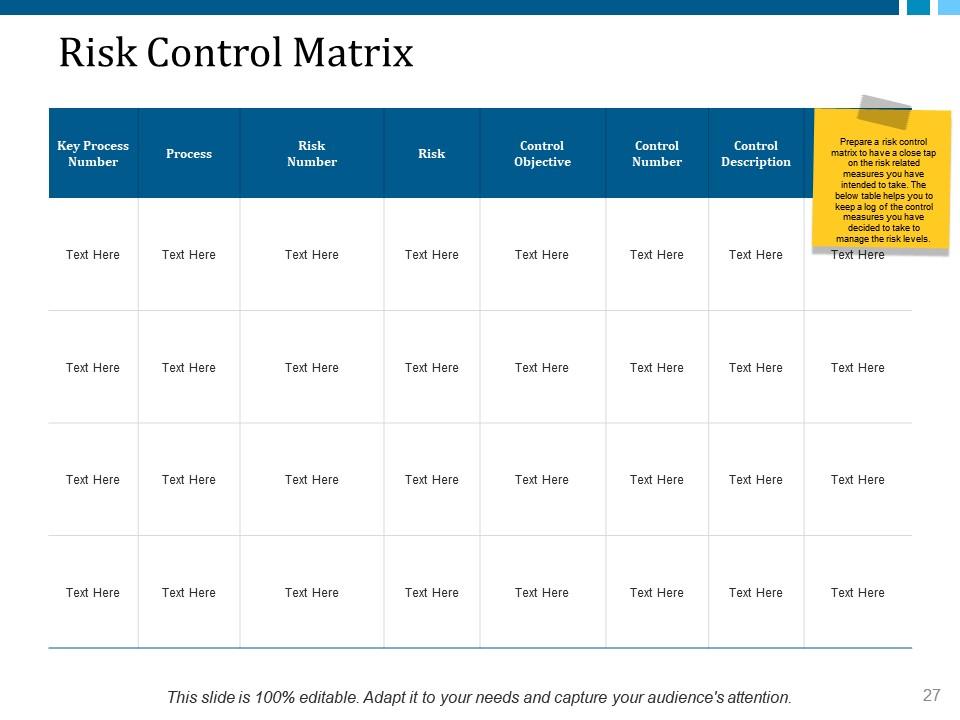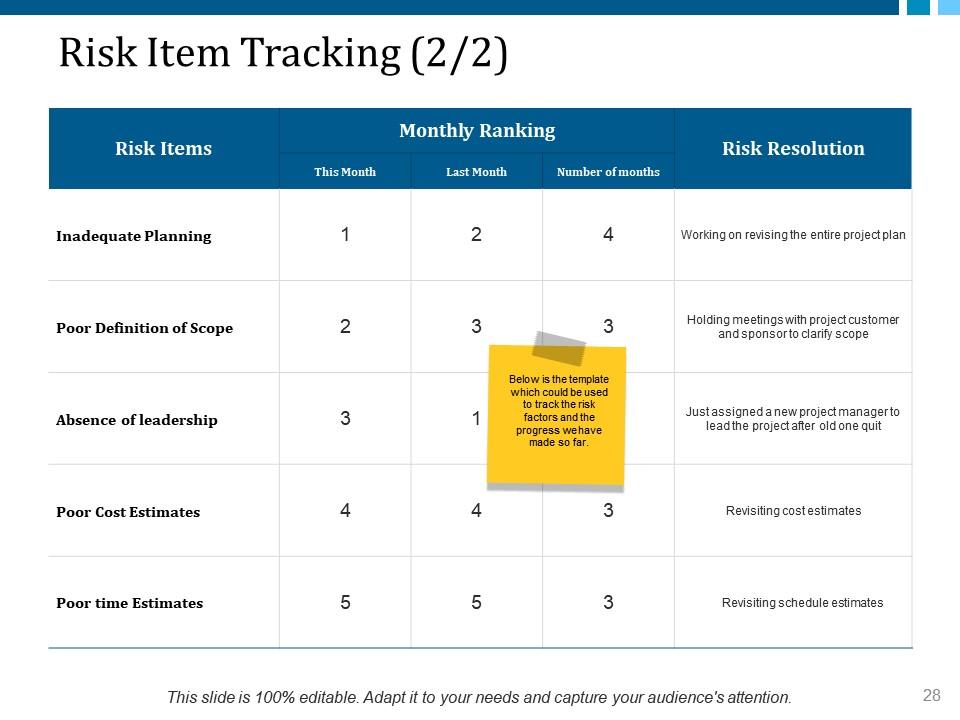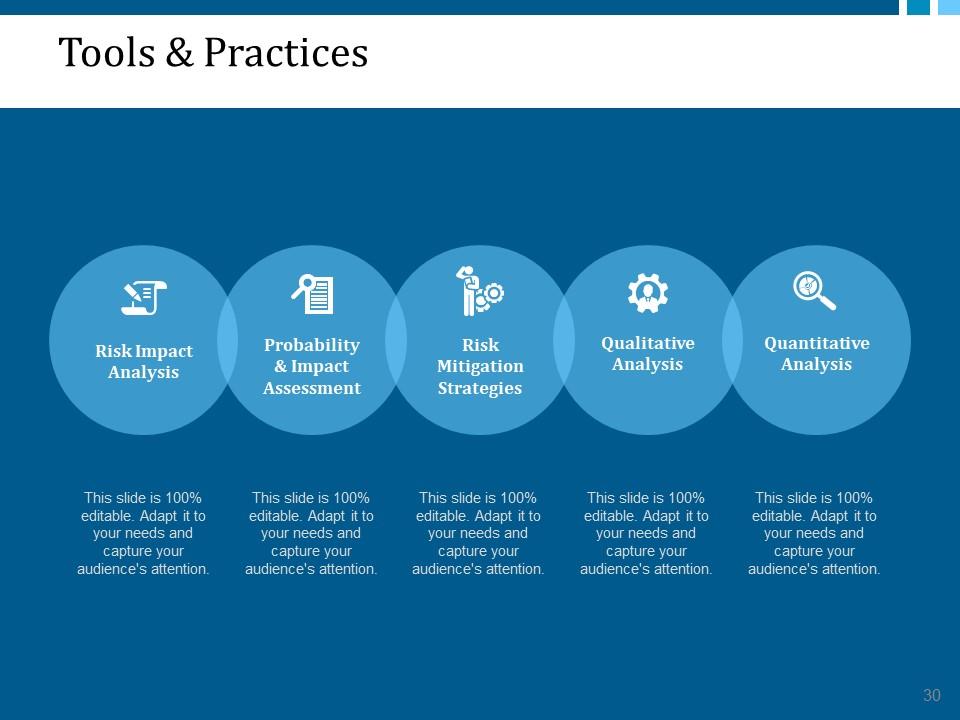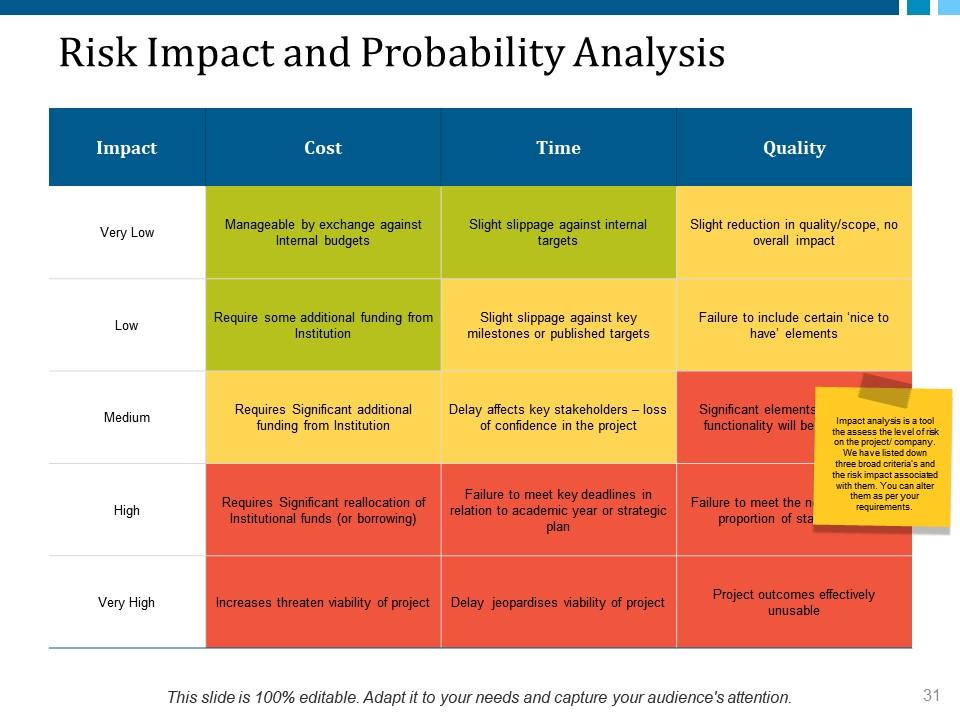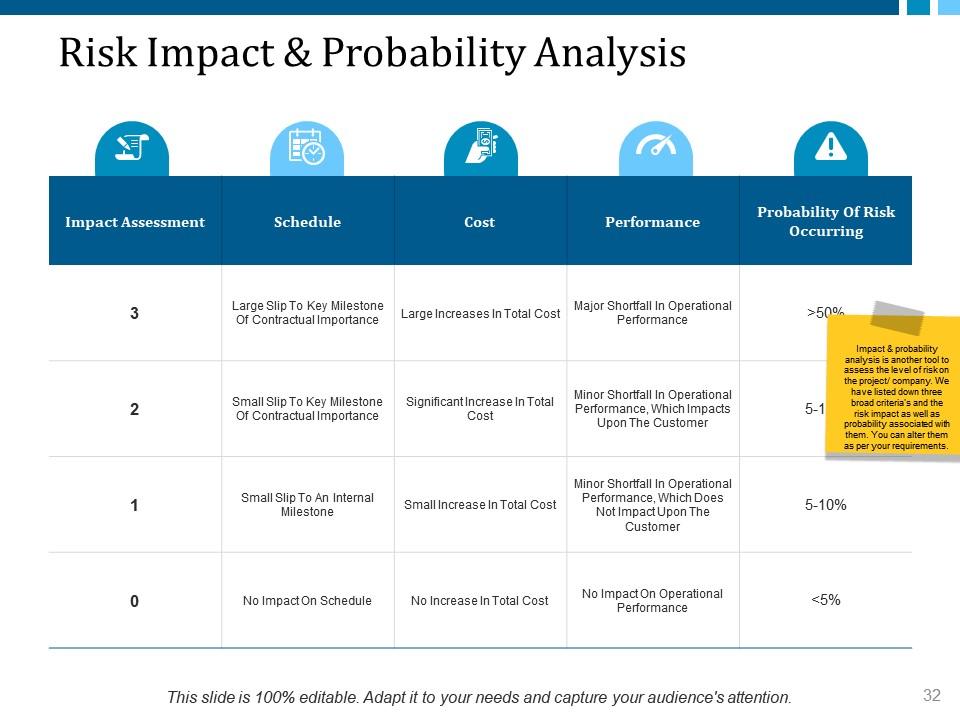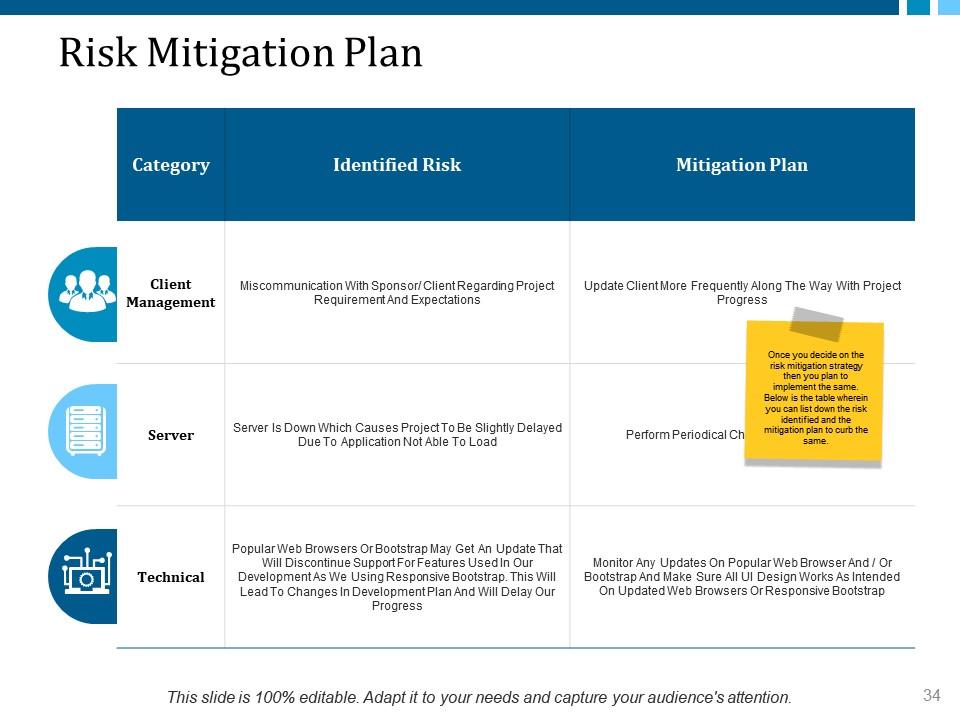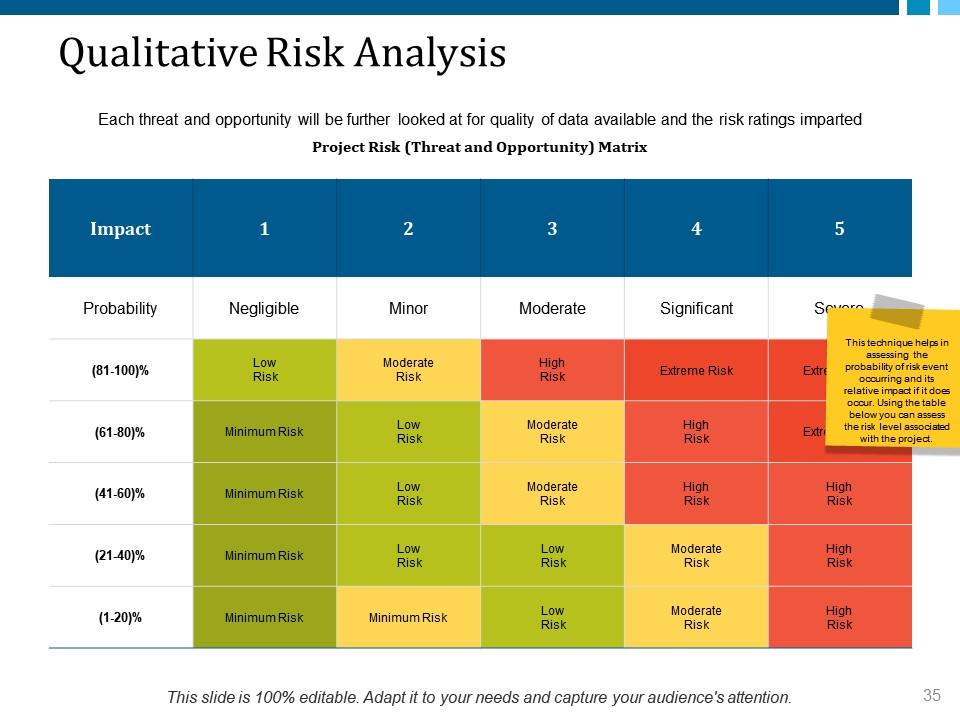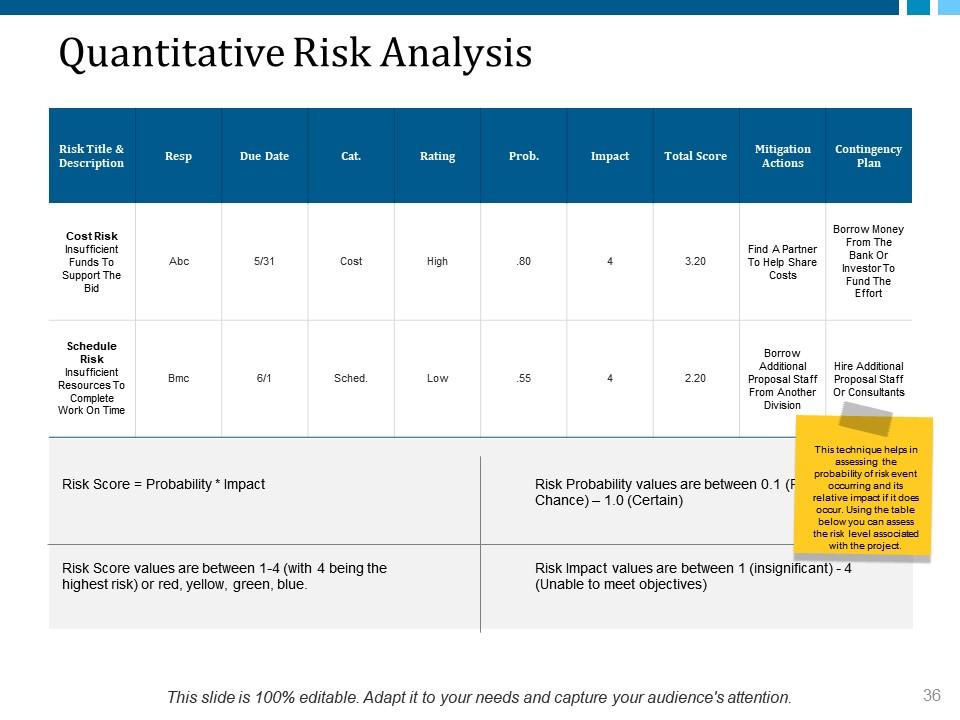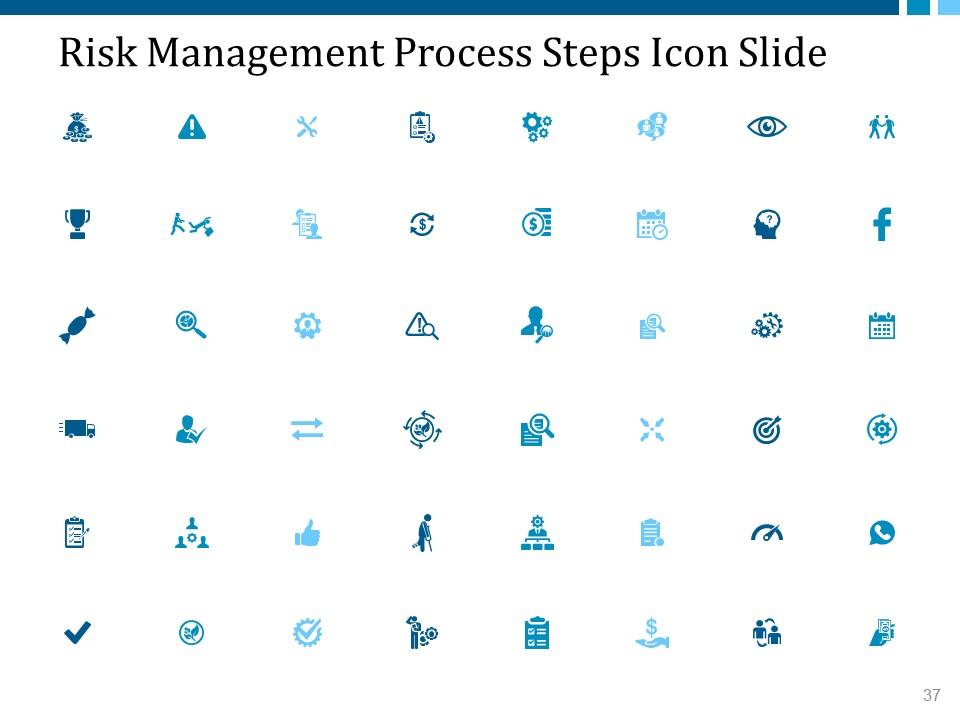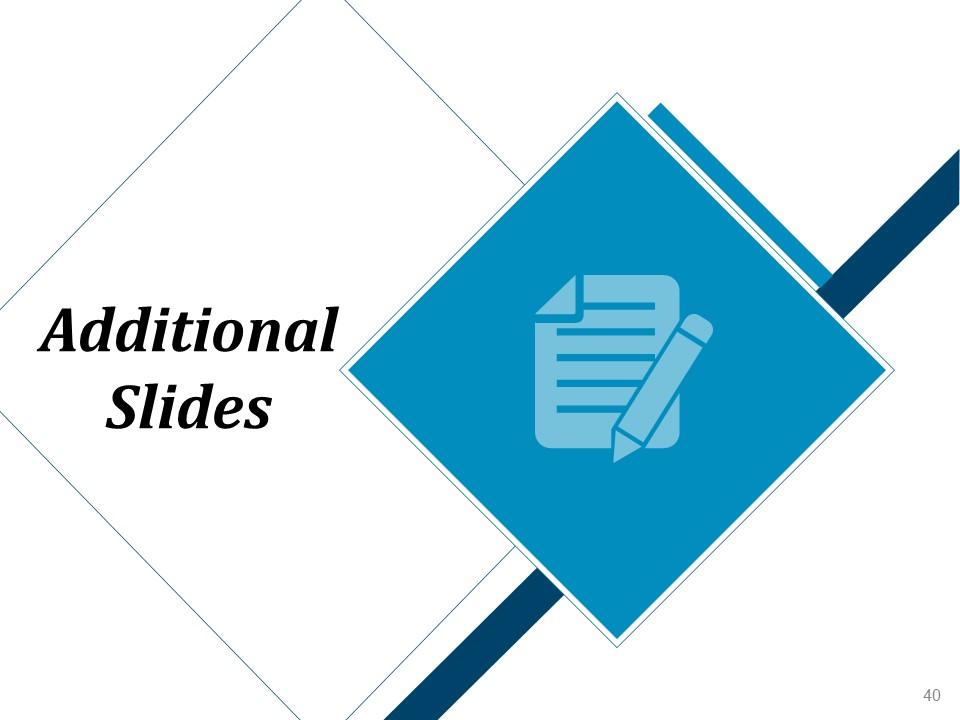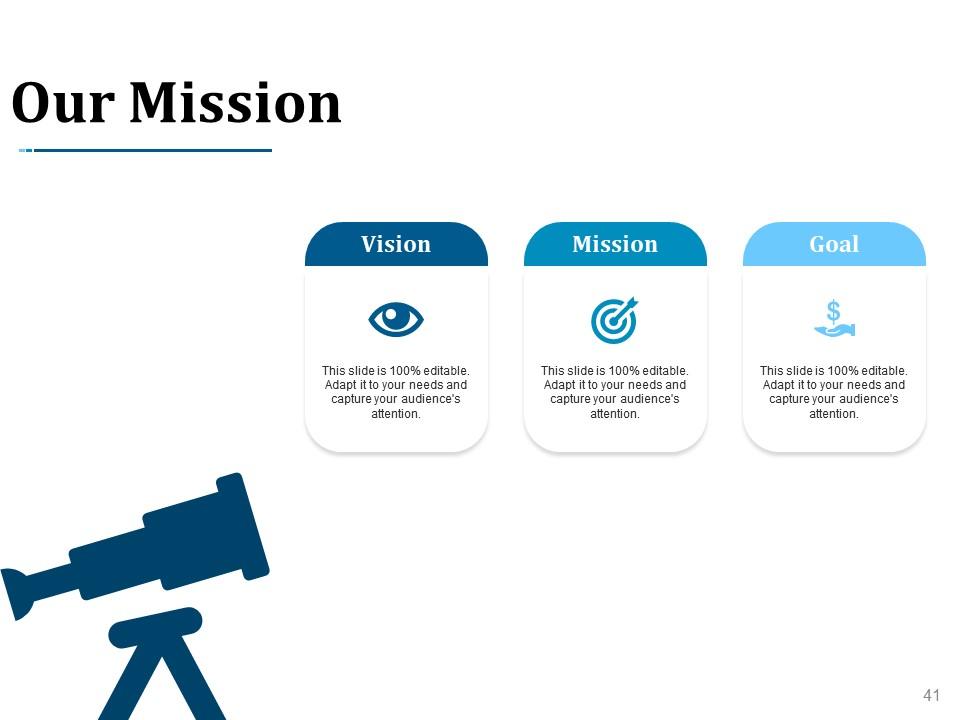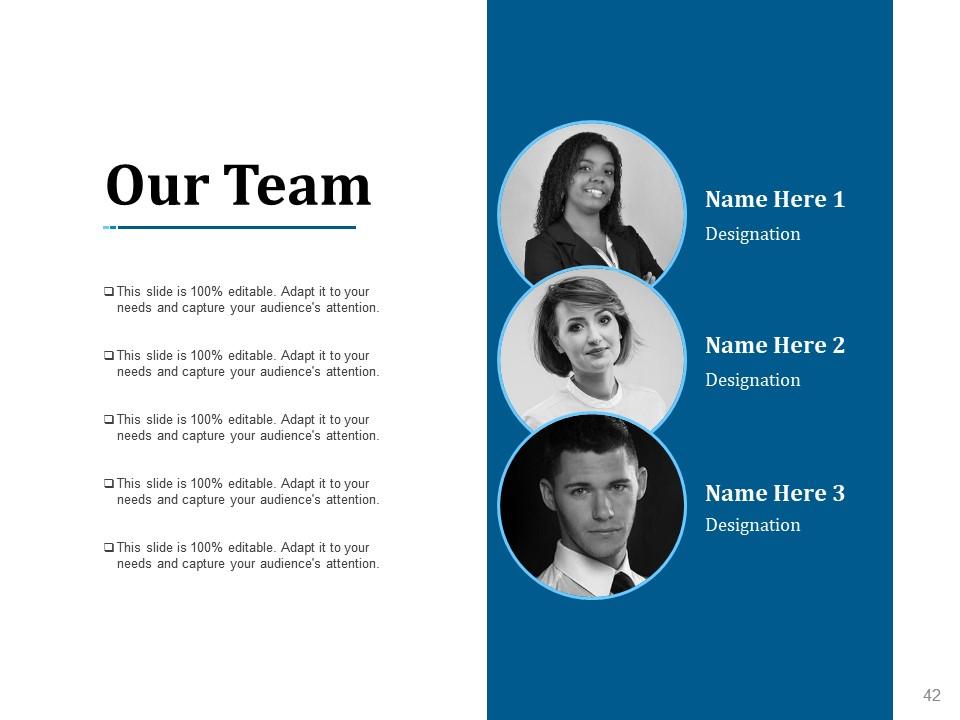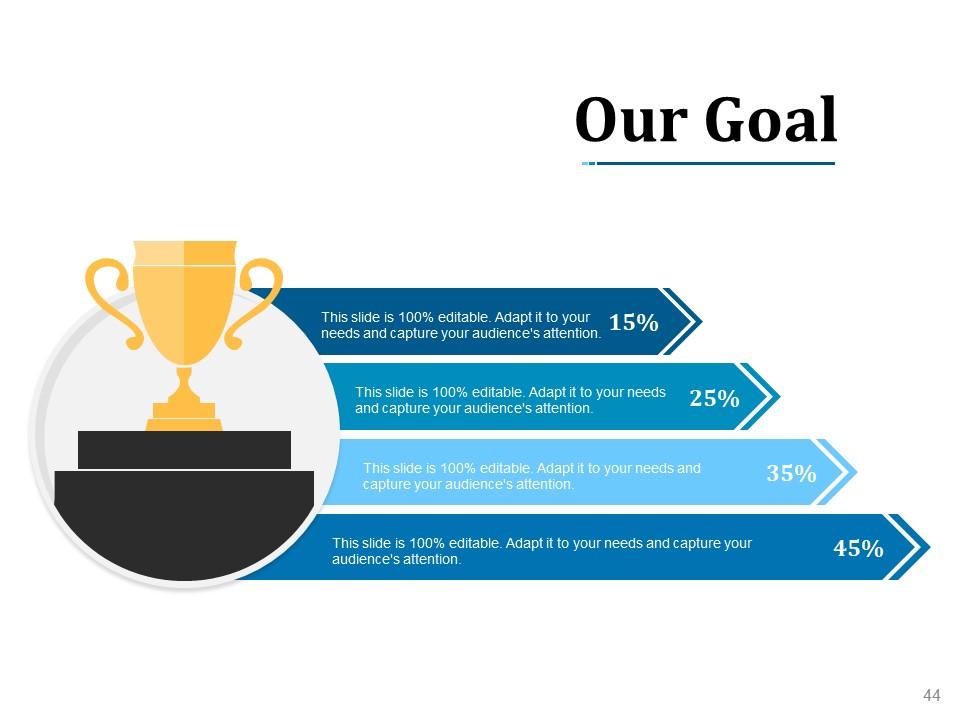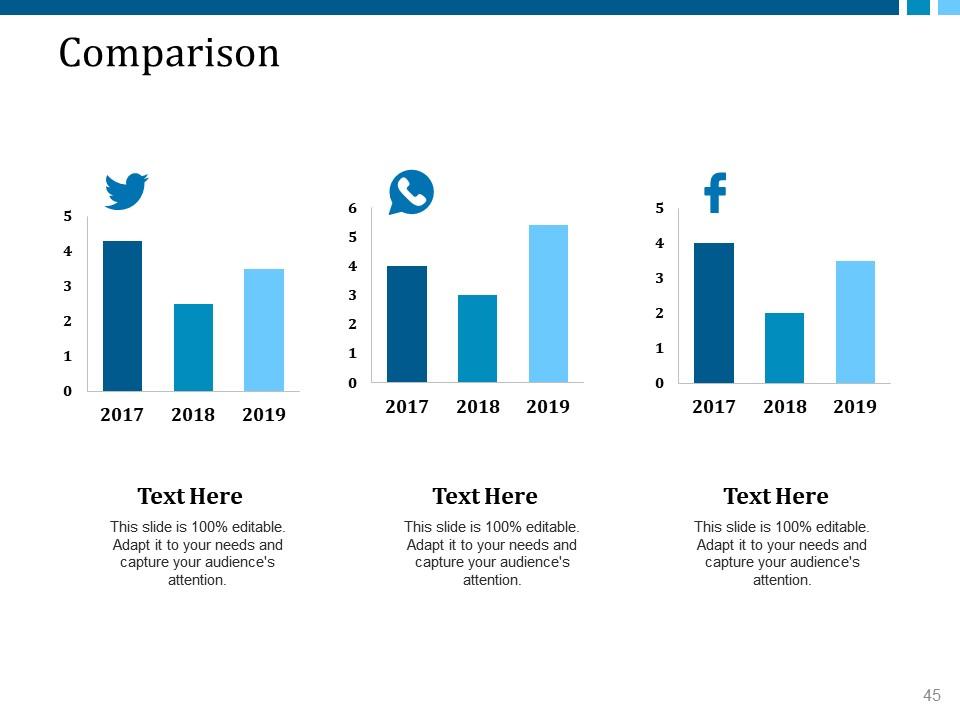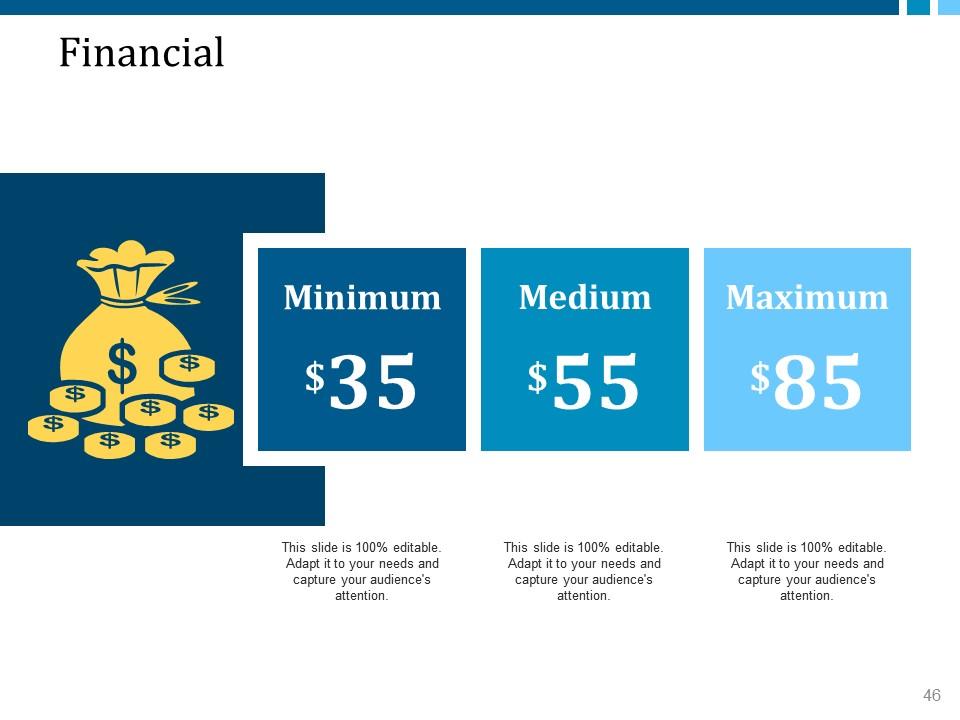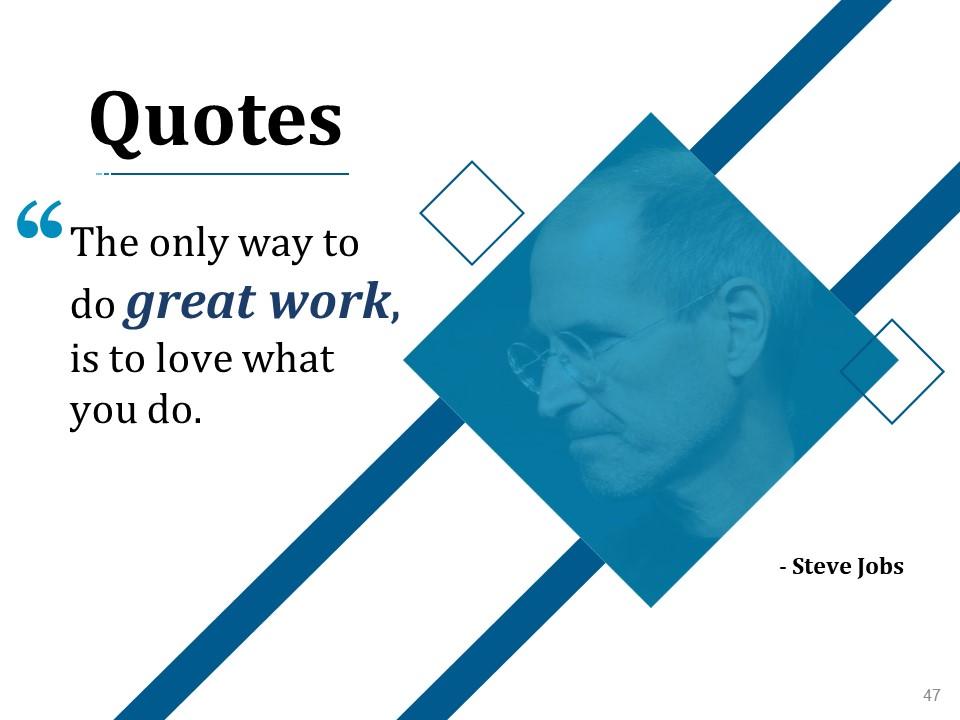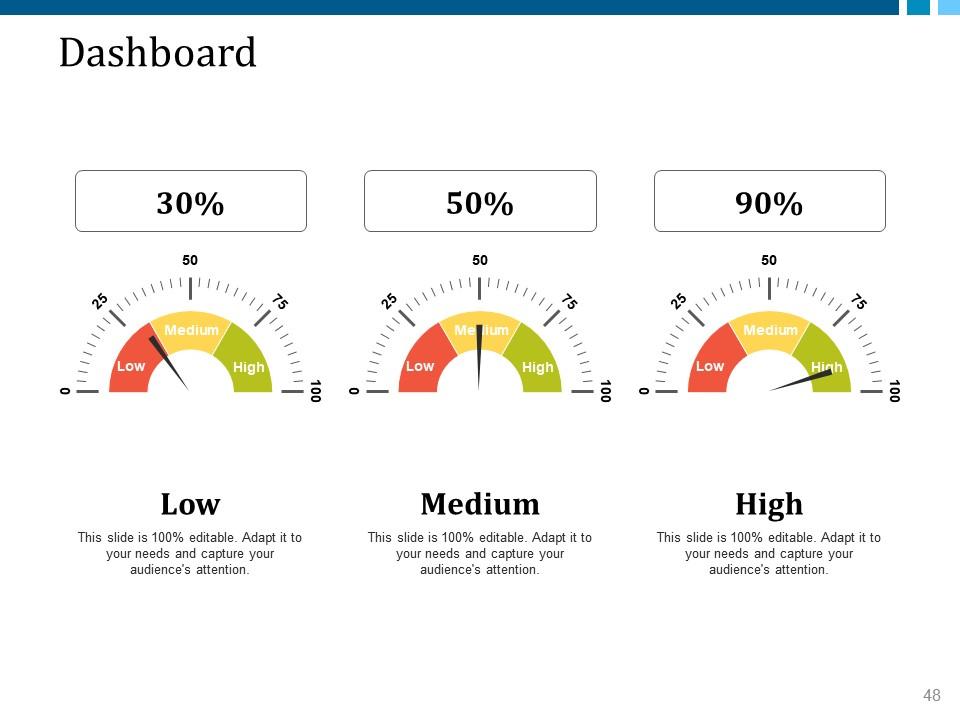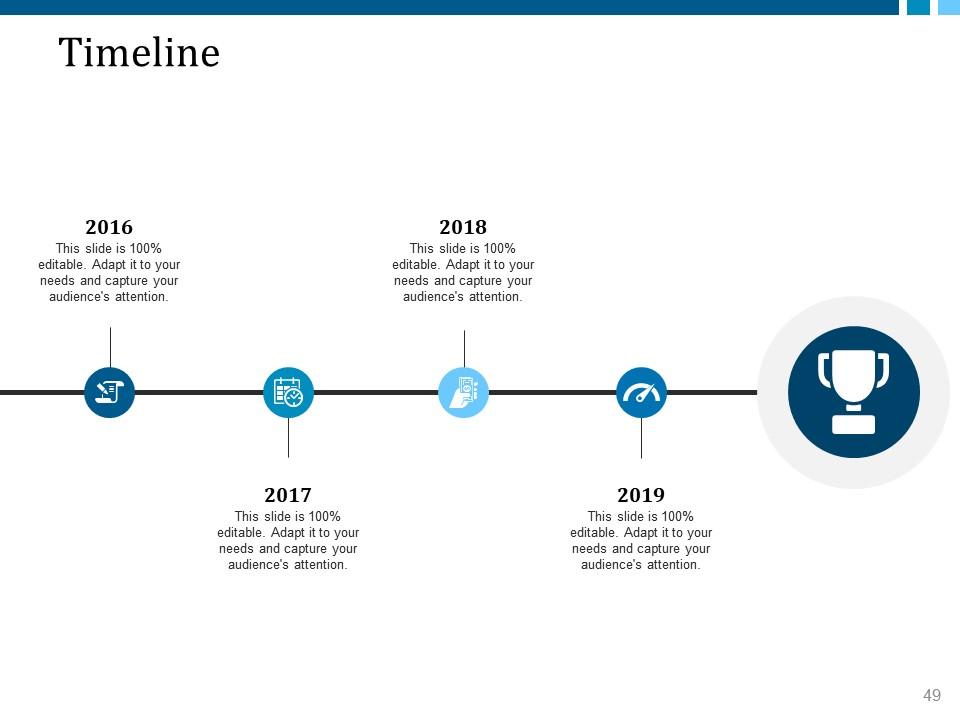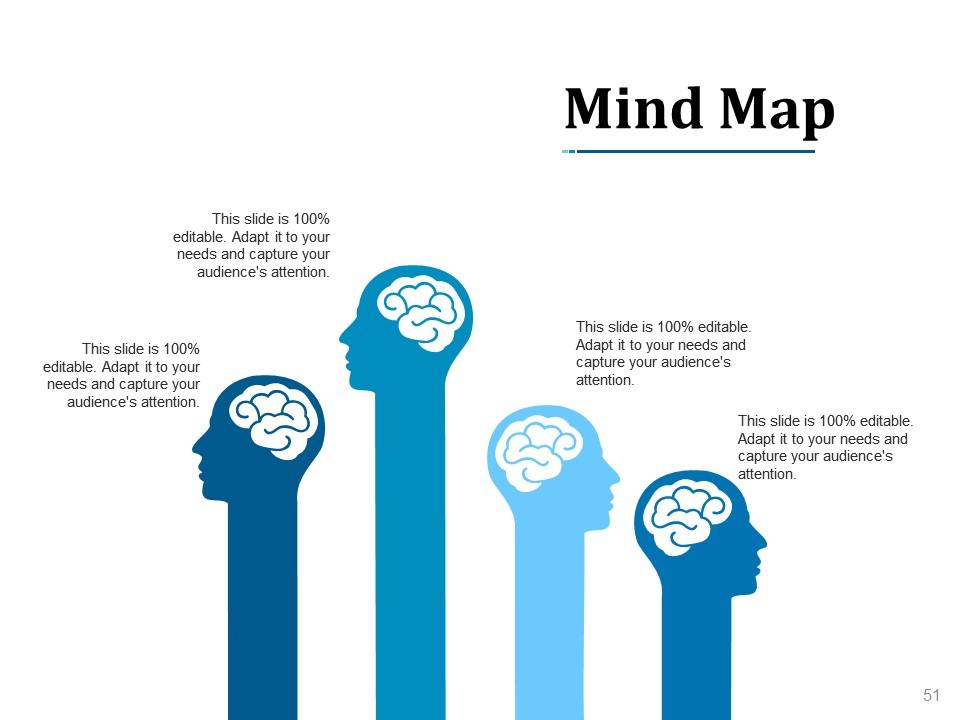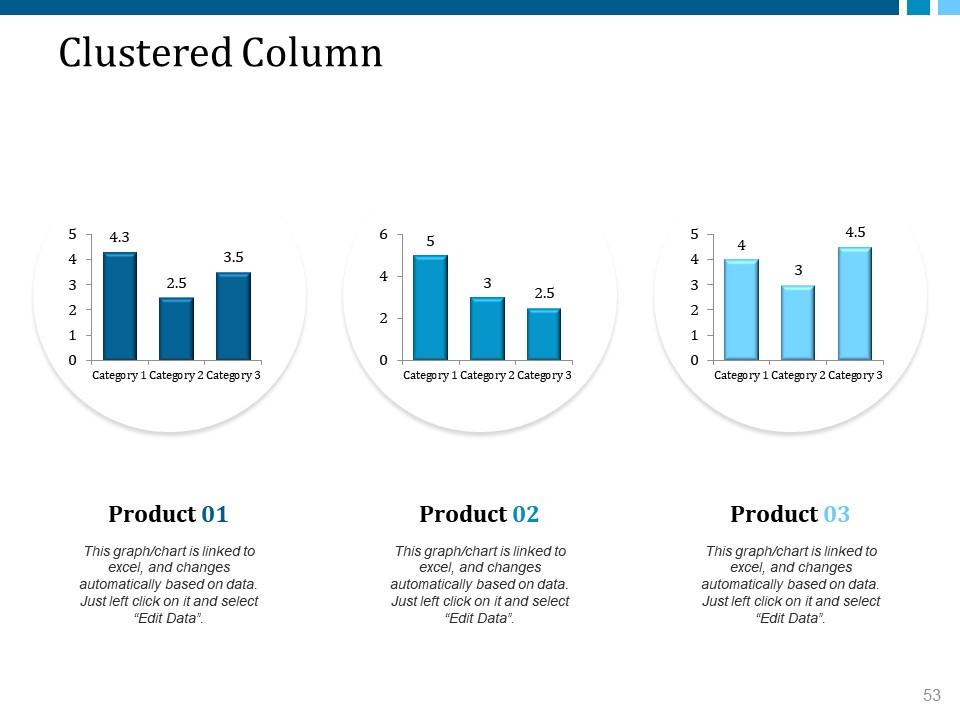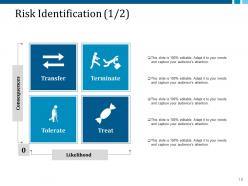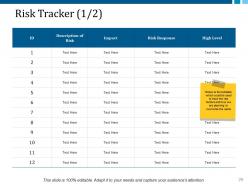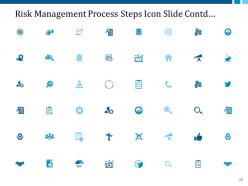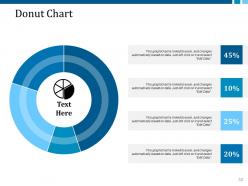Risk management process steps powerpoint presentation slides
Download Risk Management Process Steps PowerPoint Presentation Slides to identify and manage potential business risk. This risk analysis and management PowerPoint complete deck includes content ready slides such as risk management lifecycle, types of risks, risk categories, stakeholder’s management and engagement, risk appetite and tolerance, procedure, risk management plan, risk identification, risk register, risk assessment, risk analysis, risk response plan, risk response matrix, risk control matrix, risk items tracking, tools and practices, risk impact & profitability analysis, risk mitigations strategies, plans, qualitative and quantitative risk analysis, etc. The content given in this Presentation has been researched by our team of experts. All slides are easy to customize. Users can edit these templates as per their requirements. Showcase risk evaluation and analysis techniques with risk response plan PPT Slides. Demonstrate the risk aspect involved in the project using the risk management approach and plan presentation graphics. Our Risk Management Process Steps Powerpoint Presentation Slides come in a fantastic array. They offer a broad canvas of exclusive craftsmanship. So, download our fully editable and customizable risk management ppt.
- Google Slides is a new FREE Presentation software from Google.
- All our content is 100% compatible with Google Slides.
- Just download our designs, and upload them to Google Slides and they will work automatically.
- Amaze your audience with SlideTeam and Google Slides.
-
Want Changes to This PPT Slide? Check out our Presentation Design Services
- WideScreen Aspect ratio is becoming a very popular format. When you download this product, the downloaded ZIP will contain this product in both standard and widescreen format.
-

- Some older products that we have may only be in standard format, but they can easily be converted to widescreen.
- To do this, please open the SlideTeam product in Powerpoint, and go to
- Design ( On the top bar) -> Page Setup -> and select "On-screen Show (16:9)” in the drop down for "Slides Sized for".
- The slide or theme will change to widescreen, and all graphics will adjust automatically. You can similarly convert our content to any other desired screen aspect ratio.
Compatible With Google Slides

Get This In WideScreen
You must be logged in to download this presentation.
PowerPoint presentation slides
It covers all the important concepts and has relevant templates which cater to your business needs. This complete deck has PPT slides on Risk Management Process Steps Powerpoint Presentation Slides with well suited graphics and subject driven content. This deck consists of total of fifty four slides. All templates are completely editable for your convenience. You can change the colour, text and font size of these slides. You can add or delete the content as per your requirement.Download PowerPoint templates in both widescreen and standard screen. The presentation is fully supported by Google Slides. It can be easily converted into JPG or PDF format.
Content of this Powerpoint Presentation
Slide 1: This slide introduces the Risk Management Process Steps. Add your company name and proceed.
Slide 2: This slide presents Content showcasing- Introduction: Risk Management- Introduced, Types of Risk, Risk Categories, Identify Risk Categories. Procedure for managing the Risk: Risk Planning, Risk Identification, Risk Assessment, Risk Monitoring, Risk Tracking. Stakeholders Engagement: Risk Appetite, Risk Tolerance. Tools & Practices: Risk Impact Analysis, Impact &Probability Analysis, Risk Mitigation Strategies, Qualitative Analysis, Quantitative Analysis.
Slide 3: This slide shows Risk Management Lifecycle with four basic steps to be followed- Identify Risks, Plan Risk Response, Analyze Risks, Monitor & Control.
Slide 4: This is an Introduction slide with points that we have metioned.
Slide 5: This slide presents Risk Management- Introduction framework. It shows the outcome of risk management for a firm which involves minimizing, monitoring & controlling unfavourable events and maximizing the opportunities.
Slide 6: This slide showcases Types Of Risks. We have presented a list of internal risks and other factors. You can add/ delete the risk types as per your requirements.
Slide 7: This is also a template showing four broad categories of Types of Risks- Strategic, Operational, Financial, Hazard. You can modify them as per your needs.
Slide 8: This slide shows Risk Categories with the following subheadings- Product Design: Product Performance, Design. System/ Software: Data Accuracy, Security. Manufacturing: Assembly, Tools. All Other: Consumer service, Environment. Project Management: Team work, Product cost. Quality: Quality system, Sigma Levels.
Slide 9: This slide helps to Identify the Risk Categories based on the Risk level and Risk Score.
Slide 10: This slide shows Stakeholder Engagement with its two aspects- Stakeholders Risk Appetite, Risk Tolerance.
Slide 11: This slide shows Stakeholders Risk Appetite matrix. Obtain an estimate of the risk appetite of the shareholders with the help of the bar graph given which will help you in assessing the acceptable risk level.
Slide 12: This slide shows Risk Tolerance scale with Very Low, Low, Moderate, High, Very High parameters which you can use to analyse Risk Tolerance Level.
Slide 13: This slide presents a Risk Tolerance Bubble graph showing- Business Continuity Problems, Supplier Default, Loss Of Key Partnerships, IT Problems, Poor Project Management, Product Or Service Quality, Loss Of Key Managers.
Slide 14: This slide shows the Procedure with- Risk Planning, Risk Register, Risk Identification, Risk Assessment, Risk Monitoring, Risk Tracking.
Slide 15: This slide showcases Risk Management Plan. Use this template to list down the plan to manage the types of risks expected by the company.
Slide 16: This slide shows Risk Register. Maintain a risk register to keep a close track of all the risks faced by the company and their impact on the company performance.
Slide 17: This slide explains Risk Identification with an Example which has been showcased by us. You can alter the fields as per your requirement.
Slide 18: This slide shows another way of Risk Identification presented in a matrix form.
Slide 19: This too is a Risk Identification slide with factors like Cost, Resources, Environmental, Communication, Time, Scope.
Slide 20: This slide shows Risk Assessment with Risk Rating Guide and Risk Scoring System.
Slide 21: This is another slide showing Risk Assessment framework. On the basis of this framework, you can obtain the risk score and determine its likelihood of occurrence.
Slide 22: This slide presents Risk Analysis in a simplified format with parameters. You can alter these as per your own need.
Slide 23: This is another slide presenting Risk Analysis but in a Complex format. We have also listed the steps to be followed in calculating the risk and its certainty with which can estimate the risk level associated with your project/ company.
Slide 24: This slide shows Risk Response Plan listing both the Positive Risks and Negative Risks. We have also mentioned different ways to respond to these risks from which you can choose as per your requirements.
Slide 25: This slide shows Risk Response Matrix. Once you estimate the risk and plan the response. The next step is to prepare a detailed response matrix stating the contingency plan, its duration and the person responsible.
Slide 26: This is also a Risk Response Matrix slide with Avoid, Retain, Transfer, Retain as factors.
Slide 27: This slide shows Risk Control Matrix. Prepare a risk control matrix to have a close tap on the risk related measures you have intended to take. The table given will help you to keep a log of the control measures you have decided to take to manage the risk levels.
Slide 28: This slide shows Risk Item Tracking. Use this template to track the risk factors and the progress we have made so far.
Slide 29: This slide shows Risk Tracker to track the risk factors and how we are planning to overcome the same.
Slide 30: This slide shows Tools & Practices such as Risk Impact Analysis, Probability & Impact Assessment, Risk Mitigation Strategies, Qualitative Analysis, Quantitative Analysis.
Slide 31: This slide shows Risk Impact and Probability Analysis tool. We have listed down three broad criteria's and the risk impact associated with them. You can alter them as per your requirements.
Slide 32: This slide also shows Risk Impact & Probability Analysis. Use as per your requirement.
Slide 33: This slide shows Risk Mitigation Strategies. They are used to reduce the adverse effects of risk. We have also listed down the three categories of risk and also the strategies to be opted to manage the risk levels which you can alter as per your requirements.
Slide 34: This slide shows Risk Mitigation Plan.
Slide 35: This slide presents Qualitative Risk Analysis. This technique helps in assessing the probability of risk event occurring and its relative impact if it does occur. Using the given table you can assess the risk level associated with the project.
Slide 36: This slide shows Quantitative Risk Analysis technique. It helps in assessing the probability of risk event occurring and its relative impact if it does occur.
Slide 37: This is Risk Management Process Steps Icon Slide. Alter as per need.
Slide 38: This is also Risk Management Process Steps Icon Slide. Use as per your requirement.
Slide 39: This slide shows a Coffee Break image. You can alter the content as per need.
Slide 40: This slide is titled Additional Slides to move forward. You can change the slide content as per need.
Slide 41: This is Our Mission slide. Show your company mission and goals here.
Slide 42: This slide showcases Our Team with Name and Designation to fill.
Slide 43: This is an About Us slide showing Target Audiences, Values Client, and Preferred by Many as examples.
Slide 44: This is an Our Goal slide. State them here.
Slide 45: This is a Comparison slide for comparing entities/ products etc. here.
Slide 46: This slide displays Financial scores etc. in terms of Minimum, Medium and Maximum.
Slide 47: This is a Quotes slide. Insert a quote or whatever you desire here.
Slide 48: This is a Dashboard slide with numerals to use for presenting KPIs, metrics etc.
Slide 49: This is a Timeline slide. You can present yearly growth etc. with it.
Slide 50: This slide displays Our Target with relevant imagery.
Slide 51: This slide displays a Mind map with a brain image to go with. State any additional or special aspects here you want to cover.
Slide 52: This slide displays a Donut Chart to show percentages of entities.
Slide 53: This is a Clustered Column slide to present product/ entity comparison, specifications etc.
Slide 54: This is a Thank You image slide with Address, Email and Contact number.
Risk management process steps powerpoint presentation slides with all 54 slides:
Advise folks to insist in combined effort with our Risk Management Process Steps Powerpoint Presentation Slides. Advocate joint action.
No Reviews



